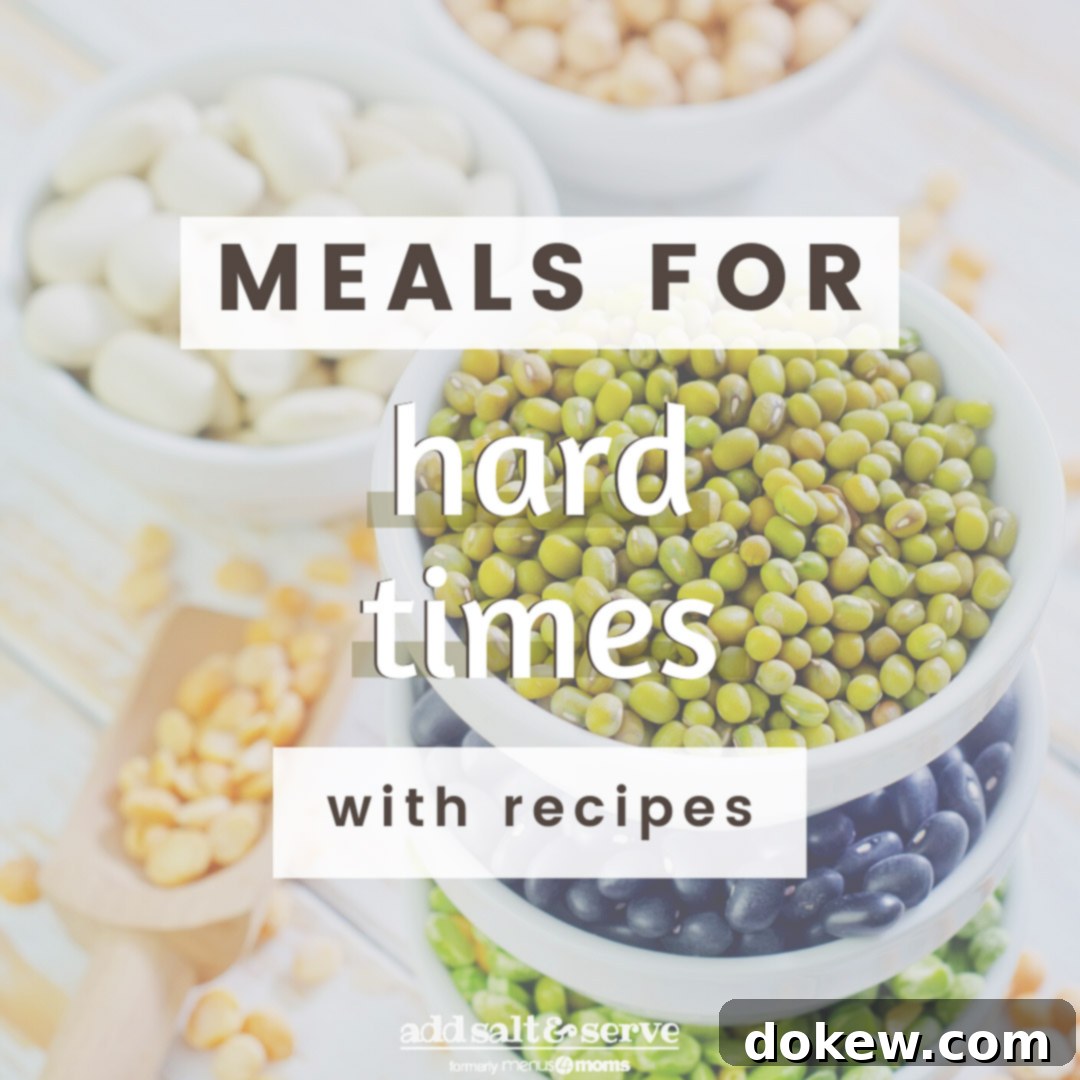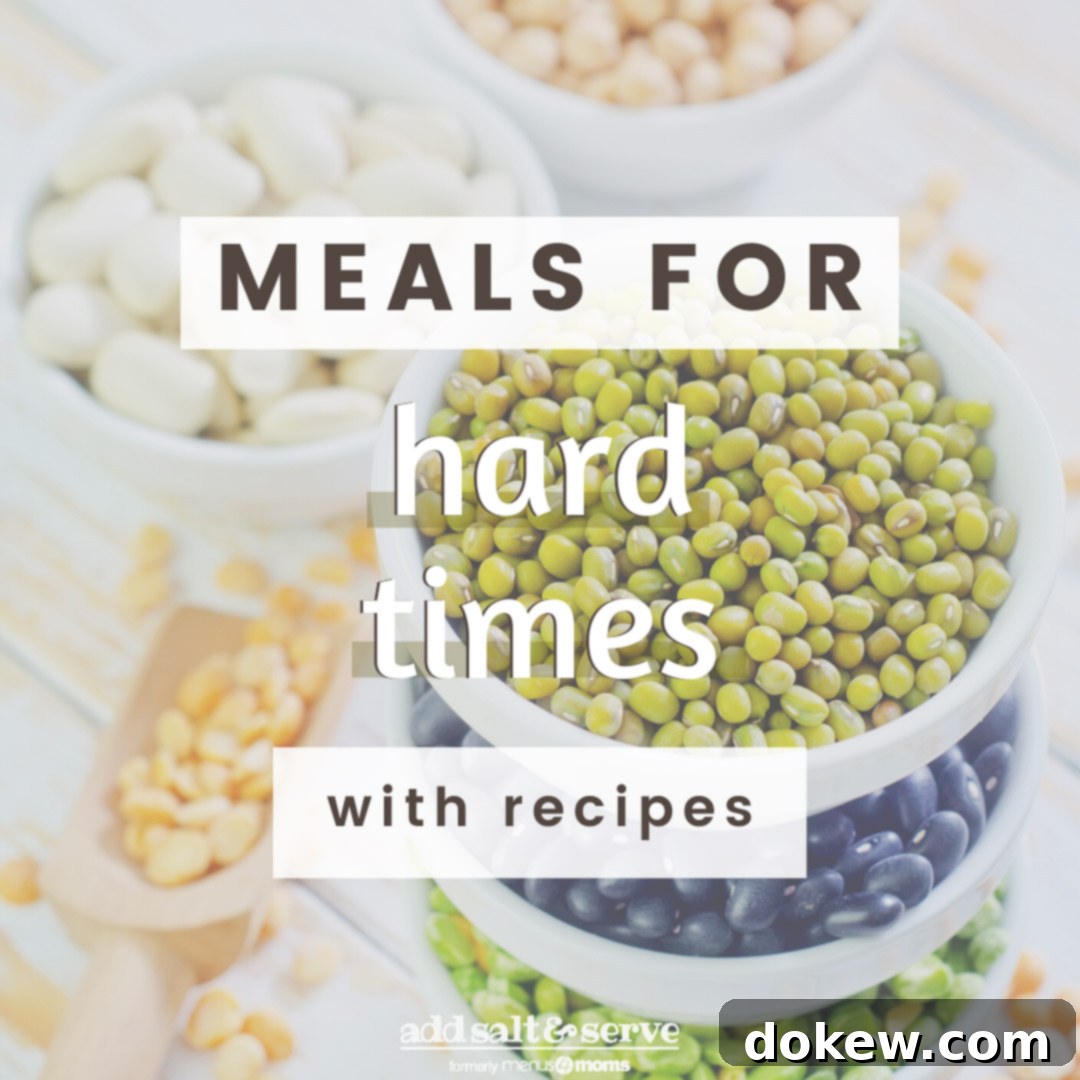Frugal Family Feast: A Week-Long Meal Plan for Hard Times on a Shoestring Budget
Life can throw unexpected financial challenges our way, from unemployment to economic uncertainty, making it crucial to manage household expenses with extreme care. During such periods, feeding your family nutritious and satisfying meals on a tight budget becomes a top priority. This comprehensive guide, adapted from a valuable series by Dee Ann Guzman and updated by Add Salt & Serve (formerly Menus4Moms), offers a practical, week-long meal plan specifically designed for these hard times. While the original article dates back to 2005, and grocery prices have naturally shifted over the years, the foundational strategies and recipes remain incredibly relevant and helpful for today’s frugal cooks. This plan will equip you with the knowledge to stretch your dollars, utilize pantry staples creatively, and provide wholesome food for your loved ones.

Essential Staples for Budget Cooking
When resources are extremely limited, a well-stocked pantry of basic, versatile ingredients is your best friend. These are the fundamental items that form the backbone of this meal plan, enabling you to create a variety of delicious and filling meals without breaking the bank. If you’re accustomed to cooking from scratch, you might already have many of these on hand. Review this list and check off what you currently possess to identify any gaps before you shop.
- Oatmeal
- Dry beans
- Rice
- Cornmeal
- 3-4 lbs. frozen chubs of ground turkey
- 1 gallon milk
- 2-3 dozen eggs
- 9 lbs. chicken leg quarters
- 1-2 cans tomato paste
- 2 cans stewed tomatoes (Italian seasoned is good)
- 1 pkg. egg noodles
- 1 pkg. spaghetti pasta
- 10 lbs. flour
- 4 cups sugar
- Cinnamon
- Baking powder
- 3-4 cups shortening
- 4 lbs. salt pork or bacon
- Margarine
- 3 onions
- A few packages of frozen veggies
- 8-10 pkgs. ramen noodles
- 1-3 cans of tuna
- Peanut butter
- Salt
- Pepper
- Oil
- Chili powder
- 1-2 cups cheese
- Raisins
- Nuts
- Celery
- 1 bag potatoes
Finding the best grocery prices can significantly impact your budget. Store options vary regionally, but here are some common choices known for their competitive pricing:
- Grocery Outlet
- Save-a-Lot
- Aldi
- Lidl
- Walmart
- Sharp Shopper
Beyond traditional grocery stores, consider leveraging seasonal abundance and local resources. For instance, during autumn, apples and pears are often ripe and plentiful. If you know anyone with fruit trees, don’t hesitate to ask if you can glean their excess. Many people are happy to have someone utilize what would otherwise go to waste. This can be a rewarding family outing and a wonderful reminder of nature’s provision. Bring home your harvest and transform it into homemade applesauce, apple pie, apple muffins, or fresh apple juice.
[Editor’s Note: At other times of the year, seasonal produce like berries or zucchini (excellent for baking zucchini bread) might be so abundant that neighbors or local farms offer them at greatly reduced prices or even for free if you inquire about less-than-perfect harvests. Always keep an eye out for these opportunities to supplement your pantry.]
Smart Shopping Strategies: What to Buy
[Editor’s Note: The comprehensive list above outlines all the ingredients needed for this meal plan. However, the original author, Dee Ann, offered valuable insights into how she would prioritize purchases on a very tight budget back in 2005. While the dollar amounts are outdated and not adjusted for inflation, her strategic thinking can still guide your decisions. We highly recommend using an inflation calculator to estimate current costs in your area and adjust your total budget accordingly.]
When shopping, always consult your local newspaper or grocery store apps for sales flyers before heading out. Planning your route in advance can also save money on gas, maximizing your savings. Let’s consider a hypothetical scenario: if chicken leg quarters are on an exceptional sale, perhaps as low as $.29/lb (a rare find today, but illustrative of strategic buying), it makes sense to stock up. For a two-week period, you might aim to buy three packages. If prices are higher, adjusting to two packages would be a sensible compromise. Assuming a purchase of three chicken quarters at this low price, your initial spend would be around $9.
Next on the priority list are fat sources: bacon, salt pork, or inexpensive ham. These are crucial for adding flavor and substance. If you already have dry beans at home, that’s a bonus; otherwise, they are a must-buy. The cheapest option for bacon is often “ends and pieces,” which works perfectly for the recipes outlined in this plan. Allocating approximately $3 for bacon and $3 for dry beans brings your total expenditure to about $15.
If your budget allows, consider adding ground turkey. Look for 1-lb. chubs on sale. For instance, if you find them at $.69/chub, purchasing four would add $2.80, bringing your total to $17.80. This demonstrates how incremental, sale-driven purchases can maximize your protein supply.
To round out your essential purchases for a $30 budget, you would need milk and eggs. At this point, you should prioritize one gallon of milk and three dozen eggs. It’s important to note that this milk is primarily for cooking, not for drinking. Families accustomed to consuming a lot of milk will need to adapt temporarily to conserve this valuable resource for meal preparation. If working with an even tighter $20 budget, you might reduce your chicken purchase by 10 lbs. to free up funds for milk and two dozen eggs, underscoring the tough choices required in extreme financial situations.
With a $20 budget, your shopping is essentially complete. For a $30 budget, the remaining balance should be spent on items that offer significant value and versatility: ramen noodles for quick meals, one or two cans of tomato paste for rich flavor, a bag of potatoes for a starchy staple, cornmeal for baking, peanut butter for a protein-packed spread, and a selection of frozen vegetables for essential nutrients. Remember, the goal is to make every dollar count, carefully selecting items that provide the most nutritional and caloric value. Prioritize these essentials first, and only allocate extra funds for “luxury” items like cheese if your budget permits after covering the basics.
Upon returning home from the store, immediately prepare your chicken quarters by dividing them into smaller, usable portions (e.g., four pieces per gallon-sized freezer bag) and freezing them. This simple step aids in meal planning and prevents waste, ensuring your protein lasts longer.
Cooking on a Budget: Your Week-Long Meal Plan
This meal plan assumes you are feeding a family of six, providing generous portions designed to be filling and often yield leftovers for subsequent meals. Resourcefulness and attention to detail will be key as we transform simple ingredients into satisfying dishes.
Shopping Day (Preparation Only)
The first day is dedicated to foundational preparations, setting the stage for the week’s cooking. This involves soaking dry beans and getting your sourdough starter active.
Beans: Begin by placing your dry beans in a large bowl and covering them with water to soak overnight. In the morning, drain the water, rinse the beans thoroughly, and add fresh water (twice the depth of the beans in the pot). Place them in a crockpot or a pot on the stove to cook on low for several hours until tender. Adding a couple of pieces of bacon or salt pork will infuse them with a rich, savory flavor.
Sourdough Starter: Simultaneously, initiate your sourdough starter. Combine one cup of milk, one cup of flour, and one teaspoon of sugar. Blend these ingredients until smooth. Cover the mixture loosely with a paper towel and place it in a warm spot. [Editor’s Note: This starter is the foundation for our sourdough bread. For those who find the instructions here unclear or prefer a more detailed guide, we recommend consulting this comprehensive sourdough starter and bread recipe for an alternative approach.]
Recipe

Sourdough Bread (Budget-Friendly)
Add to Shopping ListGo to Shopping List
Ingredients
Initial Starter
- 1 cup milk
- 1 cup flour
- 1 teaspoon sugar
Bread
- 8-12 cups flour, divided
- 1 additional quart milk, divided
- ¼ cup oil
Starter Food
- 1 cup milk
- 1 cup flour
Instructions
Make the Starter
-
Combine 1 cup milk, 1 cup flour, and sugar in a bowl. Blend until smooth. Place in a warm location, loosely covered with a paper towel.
-
Allow the starter to ferment for 2 days. After the first day, check for a distinct sour smell, indicating active fermentation.
Split & Feed the Starter (2 days after making starter)
-
Carefully transfer three-quarters of your active starter into a large mixing bowl; this portion will be used for your bread. Set the remaining quarter aside.
-
To the reserved portion of starter, add 1 cup of flour and 1 cup of milk. Mix thoroughly, then cover and refrigerate this fed starter for future use.
Make the Bread (2 days after making starter)
-
Place 1 egg (uncracked) into a glass of hot tap water to bring it to room temperature.
-
Gently warm approximately 1 quart of milk until it is lukewarm, not hot.
-
Remove the egg from the water, crack it open, and beat it lightly.
-
To the three-quarters of starter in your large bowl, add the beaten egg, ¼ cup oil, the warm milk, and 5-6 cups of flour. Mix and knead the dough thoroughly for about 8 minutes, gradually adding more flour (up to 12 cups total) until the dough reaches the desired consistency – firm but still pliable. This kneading process can be an excellent stress reliever!
-
Cover the dough and allow it to rise in a warm place overnight.
-
The next morning, gently punch down the risen dough to release air. Divide it into two equal portions and shape them into loaves. Let the loaves rise again for 1 ½ hours. Preheat your oven to 350°F (175°C) and bake until the crust is golden brown and the loaves sound hollow when tapped on the bottom.
Notes
Nutrition per serving
Share
Pin
Day 1: Hearty Beginnings
Day 1 Summary |
||
|---|---|---|
Breakfast |
||
| Fried Eggs | Bacon | Quick Muffins |
Lunch |
||
| Tuna or Egg Salad | Biscuits | |
Dinner |
||
| Beans | Cornbread | |
Breakfast. To make your eggs go further, fried eggs are an excellent choice compared to scrambled, as they tend to be portioned more precisely. Prepare one fried egg per person and cook a small amount of bacon. Complement this with a batch of quick muffins for a complete and satisfying start to your day.
Recipe

Quick Muffins (Budget-Friendly)
Add to Shopping ListGo to Shopping List
Ingredients
- 2 cups flour
- ¾ cup sugar
- 1 tablespoon baking powder, omit if using self-rising flour
- 1 teaspoon cinnamon
- ¾ to 1 cup milk with a dash of vinegar added
- ¼ cup oil
Instructions
-
Combine all ingredients in a bowl and mix well. Pour the batter into a muffin tin, filling each cup about halfway. Alternatively, pour into a loaf pan for a quick bread.
-
Bake in a preheated oven at 400°F (200°C) until golden brown and a toothpick inserted into the center comes out clean.
Notes
Nutrition per serving
Share
Pin
Morning Preparation.
Tomato Paste: To efficiently use and store tomato paste, open all cans. Drop large spoonfuls of the paste onto a cookie sheet lined with parchment paper and freeze until solid. Once frozen, transfer the tomato “nuggets” to a resealable freezer bag. This method allows you to easily add a burst of tomato flavor to dishes whenever needed, without wasting an entire can.
Beans: After breakfast, ensure your soaked beans are cooking. Drain the soaking water and replace it with fresh water, ensuring the water level is twice the height of the beans. Simmer on low heat for several hours until the beans are tender. Periodically check water levels and stir to prevent sticking.
Sourdough Starter: Check the sourdough starter you prepared last night. It should now have a distinct sour aroma, indicating it’s becoming active. Set it aside for continued fermentation until tomorrow.
Lunch. For lunch, you have two excellent choices for a satisfying and inexpensive meal: tuna salad or egg salad sandwiches. Whichever filling you choose, serve it on freshly baked biscuits. Biscuits are a frugal and filling bread option, easy to make from scratch.
I’m delighted to share my grandmother’s biscuit recipe, which she likely inherited from her own mother. This recipe emphasizes technique over strict measurements, making it a truly authentic, handed-down tradition. However, I’ve tried to provide clear, workable guidelines for you here. [Editor’s Note: If you prefer a simpler alternative, our 3-Ingredient Buttermilk Biscuit recipe is another fantastic choice for quick, fluffy biscuits.]
Recipe

Dee Ann’s Homemade Biscuits (Budget-Friendly)
